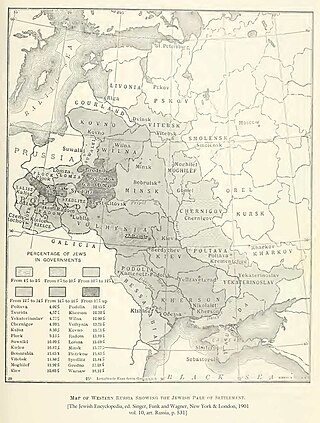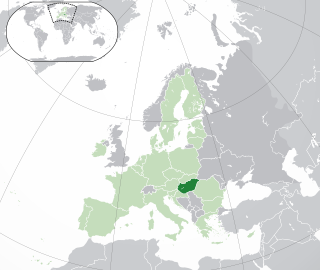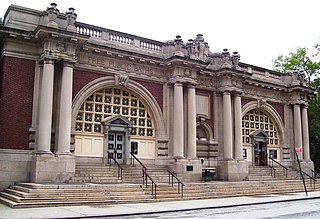
The Pale of Settlement was a western region of the Russian Empire with varying borders that existed from 1791 to 1917 in which permanent residency by Jews was allowed and beyond which Jewish residency, permanent or temporary, was mostly forbidden. Most Jews were still excluded from residency in a number of cities within the Pale as well. A few Jews were allowed to live outside the area, including those with university education, the ennobled, members of the most affluent of the merchant guilds and particular artisans, some military personnel and some services associated with them, including their families, and sometimes their servants. The archaic English term pale is derived from the Latin word palus, a stake, extended to mean the area enclosed by a fence or boundary.

The history of the Jews in England goes back to the reign of William the Conqueror. Although it is likely that there had been some Jewish presence in the Roman period, there is no definitive evidence, and no reason to suppose that there was any community during Anglo-Saxon times. The first written record of Jewish settlement in England dates from 1070. The Jewish settlement continued until King Edward I's Edict of Expulsion in 1290. After the expulsion, there was no overt Jewish community until the rule of Oliver Cromwell. While Cromwell never officially readmitted Jews to the Commonwealth of England, a small colony of Sephardic Jews living in London was identified in 1656 and allowed to remain.

Jewish emancipation was the process in various nations in Europe of eliminating Jewish disabilities, e.g. Jewish quotas, to which European Jews were then subject, and the recognition of Jews as entitled to equality and citizenship rights. It included efforts within the community to integrate into their societies as citizens. It occurred gradually between the late 18th century and the early 20th century.
Jewish emancipation in the United Kingdom was the culmination in the 19th century of efforts over several hundred years to loosen the legal restrictions set in place on England's Jewish population. Advocates of each stage of this process, in and out of Parliament, sought and eventually won the passage of laws that placed male Jews in the United Kingdom on an equal legal footing with the kingdom's other emancipated males.
The history of the Jews in Colonial America begins upon their arrival as early as the 1650s. The first Jews that came to the New World were Sephardi Jews who arrived in New Amsterdam. Later major settlements of Jews would occur in New York, New England, and Pennsylvania.

The history of the Jews in France deals with Jews and Jewish communities in France since at least the Early Middle Ages. France was a centre of Jewish learning in the Middle Ages, but persecution increased over time, including multiple expulsions and returns. During the French Revolution in the late 18th century, on the other hand, France was the first European country to emancipate its Jewish population. Antisemitism still occurred in cycles and reached a high in the 1890s, as shown during the Dreyfus affair, and in the 1940s, under Nazi occupation and the Vichy regime.
Jewish political movements refer to the organized efforts of Jews to build their own political parties or otherwise represent their interest in politics outside the Jewish community. From the time of the siege of Jerusalem by the Romans to the foundation of Israel the Jewish people had no territory, and, until the 19th century they by-and-large were also denied equal rights in the countries in which they lived. Thus, until the 19th century effort for the emancipation of the Jews, almost all Jewish political struggles were internal, and dealt primarily with either religious issues or issues of a particular Jewish community.

The Leibzoll was a special toll that Jews had to pay in most European states from the Middle Ages to the 19th century.

The history of the Jews in Hungary dates back to at least the Kingdom of Hungary, with some records even predating the Hungarian conquest of the Carpathian Basin in 895 CE by over 600 years. Written sources prove that Jewish communities lived in the medieval Kingdom of Hungary and it is even assumed that several sections of the heterogeneous Hungarian tribes practiced Judaism. Jewish officials served the king during the early 13th century reign of Andrew II. From the second part of the 13th century, the general religious tolerance decreased and Hungary's policies became similar to the treatment of the Jewish population in Western Europe.

The history of the Jews in the Netherlands began largely in the 16th century when they began to settle in Amsterdam and other cities. It has continued to the present. During the occupation of the Netherlands by Nazi Germany in May 1940, the Jewish community was severely persecuted.

Sir Isaac Lyon Goldsmid, 1st Baronet was a financier and one of the leading figures in the Jewish emancipation in the United Kingdom, who became the first British Jew to receive a hereditary title.

Sir Francis Henry Goldsmid, 2nd Baronet was an Anglo-Jewish barrister and politician.
Taxation of the Jews in Europe refers to taxes imposed specifically on Jewish people in Europe, in addition to the taxes levied on the general population. Special taxation imposed on the Jews by the state or ruler of the territory in which they were living has played an important part in Jewish history. The abolition of special taxes on the Jews followed their admission to civil rights in France and elsewhere in Europe at the end of the 18th and beginning of the 19th centuries.
Antisemitism in the Russian Empire included numerous pogroms and the designation of the Pale of Settlement from which Jews were forbidden to migrate into the interior of Russia, unless they converted to the Russian Orthodox state religion.

Tolerance tax or toleration tax was a tax that was levied against Jews of the Kingdom of Hungary, then part of the Austrian Empire, between 1747 and 1797.

Asser Levy, also known as Asser Levy van Swellem and Asher Levy, was one of the first Jewish settlers of the Dutch colony of New Amsterdam on Manhattan Island.

By the time the Ottoman Empire rose to power in the 14th and 15th centuries, there had been Jewish communities established throughout the region. The Ottoman Empire lasted from the early 14th century until the end of World War I and covered parts of Southeastern Europe, Anatolia, and much of the Middle East. The experience of Jews in the Ottoman Empire is particularly significant because the region "provided a principal place of refuge for Jews driven out of western Europe by massacres and persecution."
Lady Louisa Sophia Goldsmid was a British philanthropist and education activist who targeted her life at improving education provision for British women. She took a leading role in persuading Cambridge University to create women graduates.
Balls Pond Road Cemetery, also known as Jewish Cemetery,Kingsbury Road Cemetery, Balls Pond Burial Ground and The Jewish Burial Ground, is a Jewish cemetery on Kingsbury Road, Dalston, London N1. It was founded in 1843 and is owned by West London Synagogue. Prominent early members of that place of worship, such as the de Stern, Goldsmid and Mocatta families, are buried in this cemetery. Other notable burials include the ashes of Amy Levy, the first Jewish woman at Cambridge University and the first Jewish woman to be cremated in England. The last burial at the cemetery was in 1951. The cemetery has been Grade II listed since 2020.












